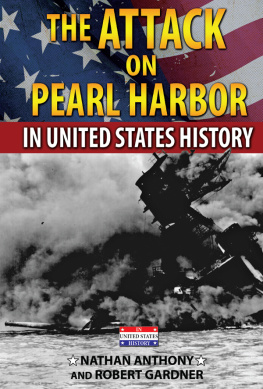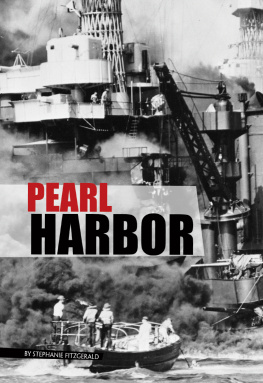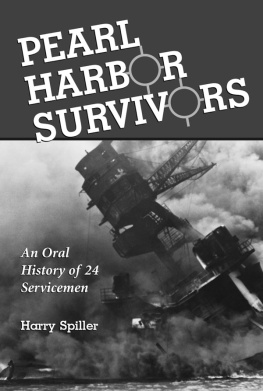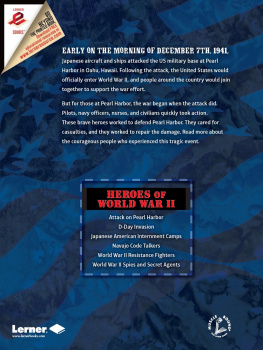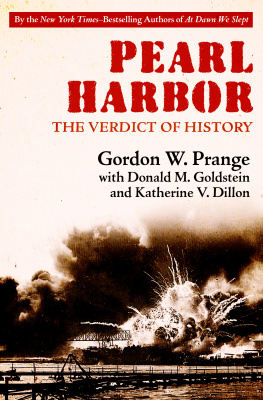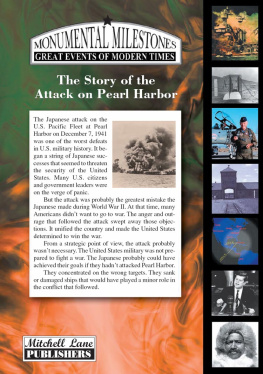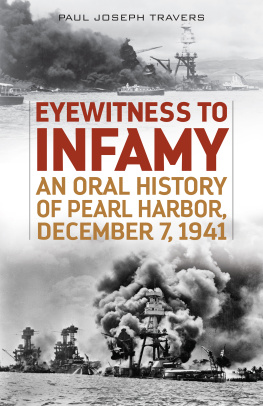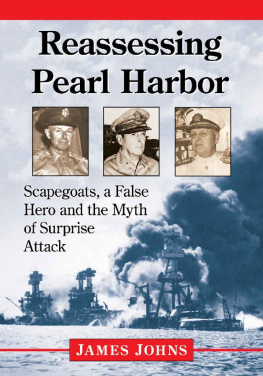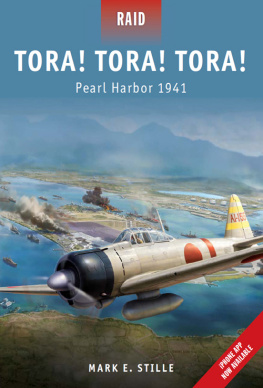A Surprise Attack
On December 7, 1941 the Japanese military launched a surprise attack on the American Naval base at Pearl Harbor, Hawaii. More than three thousand American soldiers and sailors died in the attack. Nearly every ship anchored in Pearl Harbor was damaged or destroyed. Within days, the United States declared war on Japan and entered World War II. Pearl Harbor started it all.
In The Attack on Pearl Harbor in United States History, authors Nathan Anthony and Robert Gardner detail the events of December 7, 1941. Included is the attack's lasting impact on American and world history. From the early morning liftoff of Japanese planes, to the final days of the war, Anthony and Gardner describe how the bombing of Pearl Harbor was the impetus for America's entry into World War II.
"The text is easily understood."
Fort Worth ISD
"...will be used by many middle and high schoolers."
Seattle schools
ABOUT THE AUTHORS
Nathan Anthony served in the United States Navy for four years during World War II. He also worked as an editor at many newspapers, including The New York Times.
Robert Gardner is a former science teacher and award-winning author who has written many books for young readers.


Image Credit: Stasys Eidiejus/Hemera/Thinkstock
North Pacific Ocean
Early in the morning of December 7, 1941, all was quiet at Hawaii's Pearl Harbor Naval Base. War was on the horizon for the United States, but the fleet was not on alert. Instead, sailors slept peacefully or ate a relaxed breakfast on their ships. No one thought of the threat posed by faraway Germany and the war in Europe. No one even thought much about the signs that Japana little more than three thousand miles awaywas preparing for war.
In 1941, war was on the minds of people around the world. In Europe, Germany and Italy were fighting the Allied countries, which included Great Britain and the Soviet Union. Germany had already invaded and defeated Poland, France, Yugoslavia, and most of Europe. Many people in America worried that soon Germany would defeat England and the Soviet Union and then attack the United States. Winston Churchill, the leader of Great Britain, wanted the United States to help fight against Germany.
Still, most Americans did not want to fight in a war in Europe. Many politicians and celebrities were isolationiststhose who did not want the United States to fight in a foreign war. Other Americans had heard stories of Germanys persecution and killing of European Jews and other minorities, and wanted to help Great Britain and the Soviet Union defeat Germany. These people argued that the leader of Germany, Adolf Hitler, must be stopped before it was too late.
While Americans debated joining the war in Europe, they also feared the possibility of war with Japan in the Pacific Ocean and Asia. Japan was an ally of Germany. Military leaders in Japan wanted to expand their empire in the Pacific, but the United States was in the way. The United States had military bases on many islands in the Pacific and could easily attack Japan at any time. Earlier, Japan had invaded China and northern Indochina (part of which is now Laos and Vietnam). Japanese soldiers in Nanking and Shanghai, China, had been especially ruthless. Accounts of Japanese actions in Shanghai caused widespread horror in the United States. When Japan later invaded southern Indochina, the United States responded by refusing to supply Japan with oil. Japan needed American oil to power its military. This angered the Japanese and relations between the two countries worsened. If Japan could not buy oil from America, they would take it from somewhere else.
The situation had reached the point where many American leaders, both at Pearl Harbor and in Washington, expected war. Only ten days earlier, Admiral Husband Kimmel, Commander in Chief of the Pacific Fleet, had received a strong message from the Department of the Navy in Washington, which said, This dispatch is to be considered a war warning.... An aggressive move by Japan is expected within the next few days. Still, few people believed that the Japanese would attack Pearl Harborit was too well defended.
Before World War II, most of the United States Navy fleet was stationed at Pearl Harbor. The naval base was so big that the entire United States Navy could dock, get fuel and supplies, and be repaired at one time. Pearls shapelarge, with a narrow entrancemade it one of the best harbors in the Pacific. Forts on either side of the entrance, along with coral reefs, were a barrier to any attack. In addition to the tens of thousands of naval officers and midshipmen stationed at Pearl Harbor, more than twenty-five thousand Army, Air Force, and Marine Corp soldiers were also stationed on the island of Oahu to help protect the harbor and the people of Hawaii.
On December 7, 1941, the war began dramatically for the United States. The Japanese Navy successfully launched a sneak attack on the United States bases at Pearl Harbor, Hawaii. Thousands of Americans died and many more were wounded in the attack. The raid on Pearl Harbor damaged or destroyed many of the United States naval ships in the Pacific Ocean. The event forced America to enter World War II, fighting not only Japan, but also Japans European ally, Germany. It was not until 1945 that the United States and its allies finally defeated Japan and Germany and ended World War II.
For the Japanese, the Pearl Harbor operation was highly successful. The Japanese military lost few planes in the attack and succeeded beyond their wildest expectations. With much of the American Pacific fleet destroyed or disabled, the attack cleared the way for more than six months of Japanese dominance in the Pacific. The Pearl Harbor attack showed the Japanese military at its best: organized, disciplined, and intelligent.
For Americans, Pearl Harbor will always be a date which will live in infamy as President Franklin Delano Roosevelt described it. Caught completely by surprise, Americans were embarrassed and angered by the attack. Many responded by enlisting in the armed forces to fight the Japanese and Germans, while others helped to quickly rebuild the fleet. In just over six months, the American Navy had recovered enough to defeat the Japanese at the Battle of Midway.
It all began that morning, December 7, 1941, with an attack on Pearl Harbor.
Just before three oclock in the afternoon of December 6, 1941, Takeo Yoshikawa walked out of the Japanese consulate in Honolulu, Hawaii, on the island of Oahu. He stepped into a taxi and set out for nearby Pearl Harbor to locate and count the American warships there. He had made this count many times and reported his findings to military officials in Japan. In this December report, he listed 9 battleships, 3 light cruisers, 3 submarine tenders, and 17 destroyers at anchor, and 4 light cruisers and 2 destroyers at the docks. He added that all the heavy cruisers and aircraft carriers had left Pearl Harbor. Upon completing his report Yoshikawa returned to his quarters and relaxed.
Takeo Yoshikawa was a Japanese spy. In Japan, Yoshikawa had been trained as a naval officer until a stomach ailment put an end to his early ambitions. After years of studying, Yoshikawa improved his English and learned everything he could about the United States Navy. Yoshikawa came to Oahu as a diplomat in March 1941 and began reporting on the size and the strength of the United States Navy at Pearl Harbor.

